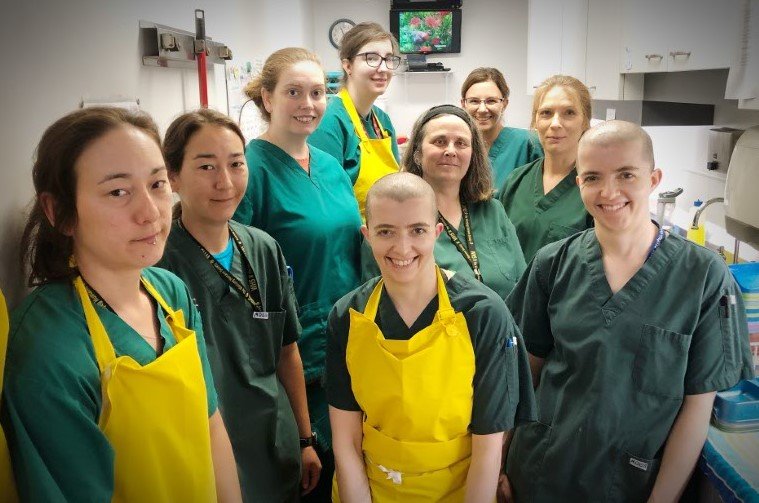
CEO Blog: Undercover Boss (not really) Series - Episode 4: Animal Care

Imagine that you are lost, all by yourself. You don’t have a cell phone, or a wallet. It is dark, and frankly quite scary. You are hungry, you are thirsty, and increasingly agitated. All of the sudden, an alien looking giant picks you up and puts you in box big enough to hold you. Next thing you know, you are in a place that is warm. You see people smile. You are asked how you are doing; you are given food and made sure you are okay.
This is not a science-fiction. What I just described is what most animals coming to the Winnipeg Humane Society experience. For stray and injured animals, and those who are surrendered to us because their caretakers can no longer look after them, arriving at a shelter is a traumatic experience on top of an already very stressful situation. Our pets may not be humans, but they are sentient beings and they absolutely get stressed and fearful.
I want you to meet our Animal Care team. This WHS team oversees feeding, cleaning, medicating and housing all our pets. They handle over 6,500 animal guests every year, and they do so with the compassion and the love that would make any CEO feel in awe. Once again, sharing time with those doing front-line work makes me realize how lucky I am to be leading this amazing charity.
For those of you who have not toured our facility, we divide our shelter into two: the adoptions section, which we call “the front”; and the shelter section housing pets not ready for adoption or under protective custody due to potential abuse, an area we call “the back”. Animal Care tends to both areas and all creatures: dogs, cats, rats, rabbits, hedgehogs (yes, hedgehogs!)
The Animal Care team start bright and early -at least for me- at 7:30am. I reported to the Senior Manager in charge of the area, Claire; and she quickly put me under the patient guidance of supervisor Ashley.
I started cleaning and feeding cats in our adoptions area – the cat condos and then Roxy took over as my trainer.
There are usually three cats in each condo, and this is what animal care needs to do:
- Spend a bit of time with the cats and record their behaviour and stress level (we call that the FAS (Fear, Anxiety and Stress) scorecard).
- Take the litterboxes out, look to make sure all poop looks good, scoop stuff out, add some in and then wipe each litterbox with sanitizing lotion (there is at least one litterbox per cat, ideally one per cat plus one extra).
- Take a look at all the toys, change any dirty/broken blankets and toys, and look at the big hanging bowls to make sure they are clean.
- Take all food plates, record if they are empty, wash each plate and let it dry while we clean.
- Clean the floors, and spot-clean any mess with soapy water with a sanitizing solution added to it.
- Look at each animal name and number and prepare the right type of food.
- Add water to the bowls and feed the cats. Make sure each cat is eating.
All seven steps happen in 10 minutes flat. One person, 10 minutes, 3 cats and a completely cleaned cat condo, plus some play time and recording key health and stress information to make sure everyone is happy. Amazing! I was given cat condos #3 and #1. It took me 18 minutes to do each, even when one of the condos had only one cat, Felix. Not too bad for a newbie. The most nerve-wracking moment was feeding 3 cats and making sure everyone was eating. One kitty wanted to eat it all, while other cat was not that interested.
In order to keep everyone healthy, we must wear a different apron for each cat condo, and after we are done we need to wipe them with a sanitizing solution before we change into a different one to keep cleaning. And we wear surgical gloves which we change with each cat condo as well.
After my cleaning duties were done, supervisor Ashley took me to administer medications with her. We had 11 (eleven!) pages, with each page listing no less than 10 pets needing meds. From pain management meds for surgical cases to treatment for a variety of illnesses, I had no idea the amount of patients we have at any given time.
Each animal has their own envelope with the medication, the dose and any specific instruction. There is no room for error, so Ashley takes a lot of precaution to make sure the right pet gets the right meds.
Ashley is amazing. For dogs, we did “meatballs”. So first you take a bit of yummy wet food for dogs, and you visit the dog to see if the pup likes the food. If they do, then we take a bit of wet food and put in the palm of your non-dominant hand (so you can open the kennel with the other), put the pill at the centre; close your hand and voilá, you have a medicated meatball!
From dogs, we then moved to cats. Felines are a lot more sensitive to smells and food, so we need to “pill” them. Essentially you hold the cat in your arms, and then lift their jaw very gently, place the pill in the mouth, massage a bit and down the hatch it goes! Then you need to spend time petting and praising so the cat has a positive experience.
After watching Ashley do two cats, she turned to me and said: “Your turn”. I was terrified. Yet, I followed her advice and I was pilling cats in no time. We also had some ear ointment treatment done, and of course we checked to make sure whatever the issue was that things were on the mend.
We even had to medicate a rabbit who had dental surgery. I did not try, but Ashley very gently and very calmly got the medication where it needed to go.
By then, my time was almost up. I will likely try to go back to do some more work with dogs and in the “back”, but I can assure all of you, donors, supporters and friends: we have a group of people that are helping to reduce the stress, heal, feed and nurture over 6,500 pets in need every year.
Another day working in the front-line, another day in which I am inspired by the work and the dedication of the WHS team. Ashley, Roxy and many others on the team have been doing this job for over 20 years. And they do it for the animals, and motivated by the fact that we have saved, rescued and given another chance to so many wonderful pets.
Thank you for supporting our team. And thank you for reading this blog. If you’d like to read the previous posts in this series, you can do so here.
In service,
Javier Schwersensky
WHS CEO

